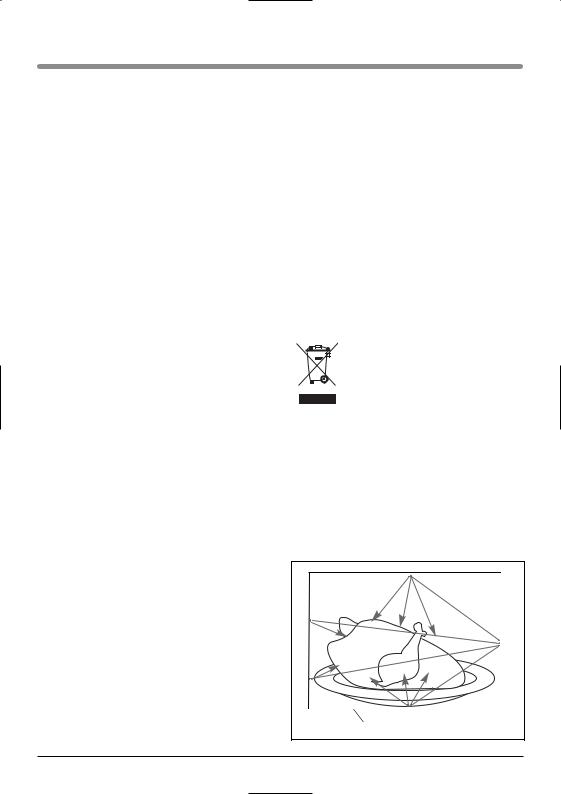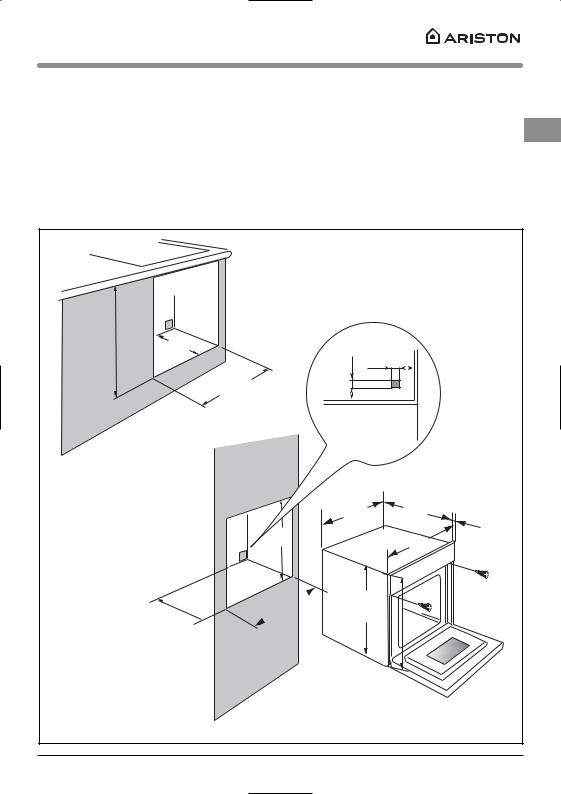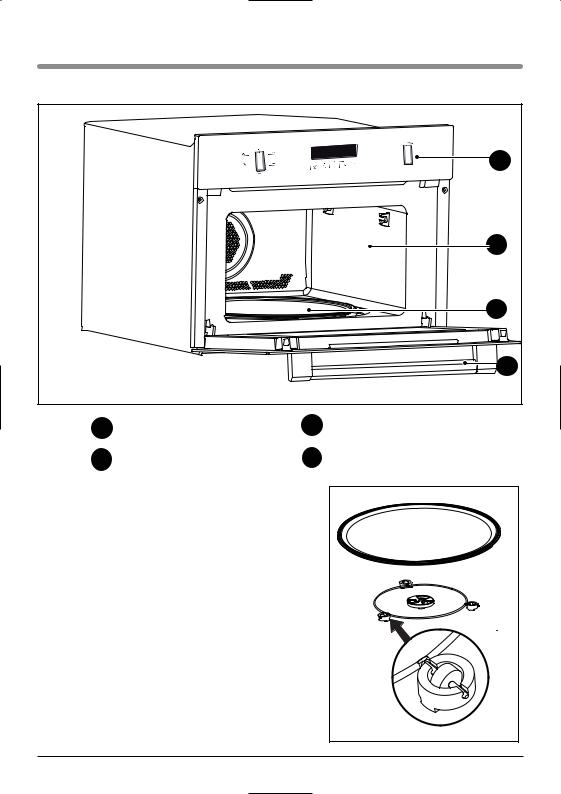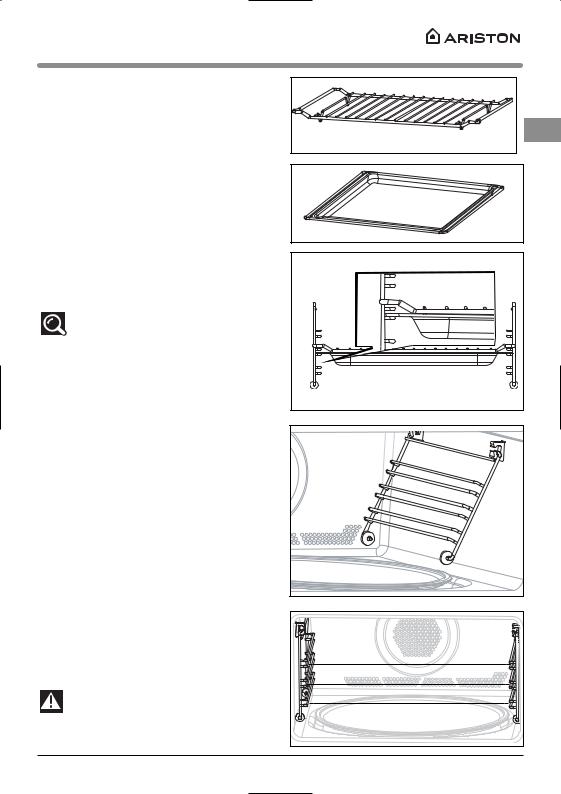ARISTON MWKA 422 X S User Manual

Instructions for use
EN
IT |
|
|
|
EN |
|
|
FR |
|
Contents |
|
|
|
|
|
|
|
|||
|
|
|
|
|
|
|
|
|
Information for the user, 2 |
Italiano |
English |
Français |
|||||||
|
|
|
|
|
|
|
|
|
Installation, 4 |
ES |
|
|
|
PT |
|
|
DE |
|
|
|
|
|
|
|
|
|
|
|
Description, 6 |
Español |
Português |
Deutsch |
|||||||
|
|
|
|
|
|
|
|
|
Use, 10 |
NL |
|
|
|
PL |
|
|
|
|
|
|
|
|
|
|
|||||
|
|
|
|
|
|
Maintenance and cleaning, 19 |
|||
Nederlands |
Polski |
|
|
||||||
|
|
|
|
|
|
|
|
|
Troubleshooting, 20 |
|
|
|
|
|
|
|
|
|
Efficiency test, 21 |
|
|
|
|
|
|
|
|
|
|
|
|
|
|
|
|
|
|
|
|
|
|
|
|
|
|
|
|
|
|
|
|
|
|
|
|
|
|
|
|
|
|
|
|
|
|
|
|
|
|
1

Information for the user
Thank you for choosing a ARISTON combination microwave. Making this product easy to use and simple to operate was the main factor considered in its development.
This combined microwave oven brings together the characteristics of a microwave with those of a traditional oven.
The various settings available allow you to choose the exact cooking method that you wish to use. This oven is designed to ensure that the control buttons are easy to use.
The controls are arranged in a practical way on the control panel. The display provides information and helps you to adjust settings.
operating principle
The microwaves used for cooking are electromagnetic waves. They are present naturally in the environment in the form of radio waves, or light or infrared rays.
Their frequency is in the 2,450 MHz range. Their properties:
-They are reflected by metal.
-They travel through all other materials.
-They absorb water, fat and sugar molecules.
When food is exposed to microwaves, the molecules are shaken rapidly, generating heat.
The microwaves penetrate the food up to a depth of around 2.5 cm. If food items are thicker, they will be cooked through to the centre by heat conduction, as in traditional cooking.
It is important to know that microwaves trigger a simple thermal reaction within the food and that they are not harmful.
protecting the environment
The packaging for your appliance is made from recyclable materials. Recycle them and help to protect the environment by disposing of them in the council receptacles provided for this purpose.
Your appliance also contains various
recyclable materials. It is therefore marked with this logo to inform you that worn-out appliances should not
be disposed of with other waste. Appliance recycling organised by
your manufacturer will thus be carried out in optimum conditions, in accordance with European directive 2002/96/EC on waste electrical and electronic equipment. Please contact your local council or your dealer for information on the worn-out appliance collection points nearest to your home. We thank you for your help in protecting the environment.
2

Information for the user
IMPORTANT SAFETY INSTRUCTIONS - READ CAREFULLY AND RETAIN FOR
FUTURE USE.
If the appliance is ever sold or transferred to another person, ensure that the new owner receives this user guide. Please read these guidelines before installing and using your appliance. They were written for your safety and the safety of others.
safety recommendations
Your appliance is designed for standard household use for cooking, reheating and defrosting foods. The manufacturer declines any responsibility in the case of inappropriate use of the appliance.
This appliance is not intended for use by individuals (including children) with impaired physical, sensorial or mental abilities, or persons lacking in knowledge or experience, unless they receive prior supervision or instructions on using the appliance from a person responsible for their safety.
Please make sure children do not play with the appliance.
WARNING: Only allow children to use the oven without supervision, if adequate instructions have been given, so that the child is able to use the oven safely and understands the dangers of incorrect use.
WARNING: Liquids and other foods should not be heated in sealed containers because they might explode.
Use only utensils suitable for use in microwave ovens.
When heating food items in plastic or paper containers, keep an eye on the oven contents, since there is a risk of ignition.
WARNING: If the door or door seal is damaged, the oven should not be used until it has been repaired by a qualified person.
WARNING: It is dangerous for anyone other than a qualified person to perform maintenance or repairs that require the removal of the cover providing protection against exposure to microwave energy.
WARNING: The accessible parts of the appliance may become hot during use. Be careful not to touch the heating elements inside the oven. It is
recommended that you keep young children at a EN safe distance. If the appliance is being used in combination mode, it is recommended that
children only use the oven under adult supervision due to the temperatures involved.
If smoke appears, stop or unplug the oven and leave the door closed to smother any flames that might appear.
Heating eggs in their shells or whole hardboiled eggs in a microwave oven is not recommended, as they may explode, even after cooking has ended. Heating beverages in a microwave oven can cause sudden and/or delayed splashing of boiling liquid, so precautions must be taken when handling containers.
The contents of baby bottles and baby food jars should be shaken or stirred and their temperature checked before consumption, to avoid burns. Never heat a baby bottle with the teat on (risk of explosion). The use of metal cookware, forks, spoons, knives or metal staples or fasteners on defrosting bags is not recommended.
Always use oven mitts to remove dishes from the oven. Some dishes absorb the heat from foods and can therefore become very hot.
If cooking small quantities of food (a sausage, croissant, etc.), place a glass of water next to the food.
Excessive cooking times may dry out foods and burn them. To prevent this happening, never use the same times as recommended for cooking in a traditional oven. To avoid damaging your appliance, never operate it while empty or without the turntable. Do not leave any accessories in your oven when it is switched off.
3

Installation
before connection
Warning:
Ensure that your appliance has not been damaged during transport (broken seal or door, etc.). If you notice any kind of damage, contact your retailer before use.
electrical connections
Ensure that:
-the electrical installation is of an adequate voltage.
-the power cable is in good condition,
-the diameter of the wires complies with installation requirements,
-your electrical installation is equipped with protection rated at 16 amperes minimum.
If in doubt, consult an electrician.
The electrical connections must be made before installing the appliance in its housing.
Electrical safety must be guaranteed by correct installation in the housing. During installation and maintenance operations, the appliance must be unplugged from the mains; the circuitbreaker tripped or the fuses removed.
The appliance must be connected using a (standardised) power cable equipped with 3 1.5 mm² conductors (phase + neutral + earth), connected to a single phase 220-240V ~ system using an IEC 60083 standardised socket (phase + neutral + earth) or in accordance with installation requirements. The green/yellow safety conductor is connected to the  appliance’s terminal and must be connected to the installation’s earth system.
appliance’s terminal and must be connected to the installation’s earth system.
In order to easily locate the reference information for your appliance, we recommend that you make a note of it on the “After-Sales Service” page.
If the appliance has an electrical plug, it must remain accessible after the appliance has been built in.
The oven’s neutral conductor (blue wire) must be connected to the system’s neutral conductor.
It must be possible to disconnect the appliance from the power supply, either using a plug or by fitting a switch on the fixed wiring system in accordance with installation rules.
If the power cable is damaged, it should be replaced by the manufacturer, its after-sales service department or by a similar qualified person, to avoid danger.
Warning:
We cannot be held responsible for any accident resulting from a non-existent, faulty or incorrect earth.
If there are any problems with the oven, unplug it or remove the fuse corresponding to the oven supply wire.
4

Installation
building in
The appliance may be installed under a worktop or in a tall kitchen unit (open or closed) that has the EN appropriate dimensions for built-in installation (Fig. 1).
Never use the appliance immediately (wait 1 to 2 hours) after moving it from a cold place to a warm place because condensation could cause a malfunction.
450 |
550 |
378 |
|
|
|
|
|
|
|
||
|
|
|
50 |
50 |
20 |
|
|
|
|
|
|
|
|
560 |
10 |
|
|
|
|
|
|
|
|
|
|
|
550 |
|
400 |
|
|
450 |
|
|
23 |
|
|
|
|
595 |
|
|
|
|
|
|
|
|
550 |
560 |
445 |
|
456 |
|
|
|
|
||
|
|
|
|
|
Fig. 1 |
|
|
|
|
|
5 |

Description |
|
|
|
appliance |
|
|
|
|
|
|
A |
|
|
|
B |
|
|
|
C |
|
|
|
D |
|
|
|
Fig. 1 |
A |
Control panel |
C |
Turntable |
|
|
|
|
B Oven cavity |
D Door handle |
Turntable: for the even cooking of foods with no handling required.
It rotates in both directions. If the turntable does not rotate, ensure that all components are correctly positioned.
Do not try to rotate it manually as this might damage the turning gear.
It can also be used as a cooking dish. To remove it, pick it up using the access zones provided in the cavity.
The support with drive spindle: guides the glass turntable as it rotates (Fig. 2).
The support wheels: The wheels must be oriented in the right direction (Fig. 2).
If they do not turn correctly, check for any foreign bodies underneath.
Fig. 2
6

Description |
|
|
accessories |
|
|
The wire shelf (Fig. 1): allows you to brown or |
EN |
|
grill food. The shelf should not, under any |
||
circumstances, be used with other metal |
Fig. 1 |
|
cookware when using the microwave, grill + |
|
|
microwave or fan + microwave settings. |
|
|
However, you may heat food in an aluminium tray |
|
|
providing it is separated from the shelf by a |
|
|
plate. |
Fig. 2 |
|
|
||
Enamel dish (Fig. 2): |
|
|
this can be used as a bain-marie filled with |
|
|
water to mid-height, for fan-assisted cooking. It |
|
|
may also be used as a cooking dish. |
|
|
Comments: |
|
|
Ensure that the enamel dish is positioned |
|
|
correctly in the middle of the shelf to allow air to |
|
|
circulate freely. Do not use the enamel dish for |
|
|
combined conventional and microwave cooking. |
|
|
There is a risk of damage. |
|
|
The shelf + the enamel dish: |
Fig.3 |
|
to roast and collect the cooking juices, place the |
|
|
shelf over the enamel dish (Fig. 3). |
|
|
Side shelves (Fig. 4): 2 shelf supports fitted with |
|
|
hooks allow you to use the accessories at |
|
|
three heights. |
|
|
There are three possible levels, depending on |
|
|
the cooking method and type of food (Fig. 4/5). |
|
|
With the Grill or Grill + Microwave settings, the |
|
|
accessories are placed on the first level for thick |
|
|
foods like roasts and on the third level for thinner |
|
|
foods like chops and sausages. |
|
|
With the fan oven setting you can use the shelf |
Fig.4 |
|
or the enamel dish on the first or second level as |
||
|
||
a cooking dish. |
|
|
|
3 |
|
|
2 |
|
Warning: |
1 |
|
Do not use the enamel dish for combined |
|
|
conventional and microwave cooking. There is a |
|
|
risk of damage. |
Fig.5 |
|
|
7 |
